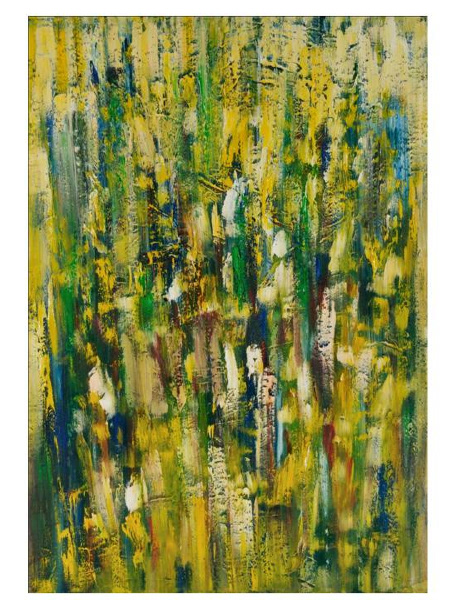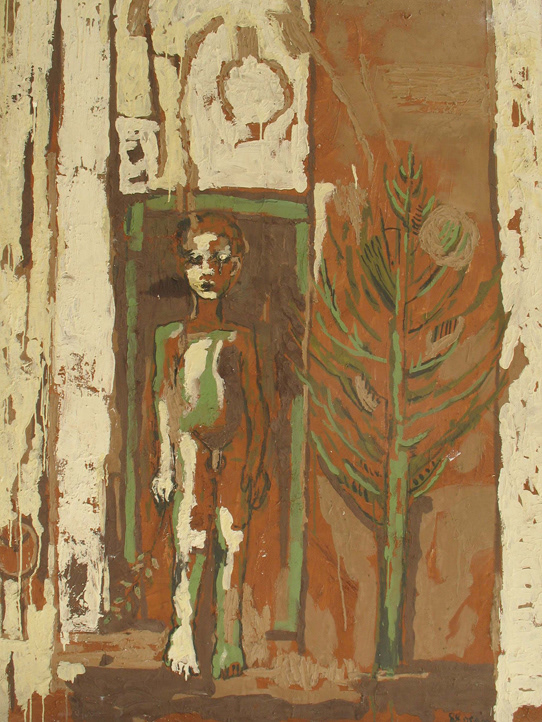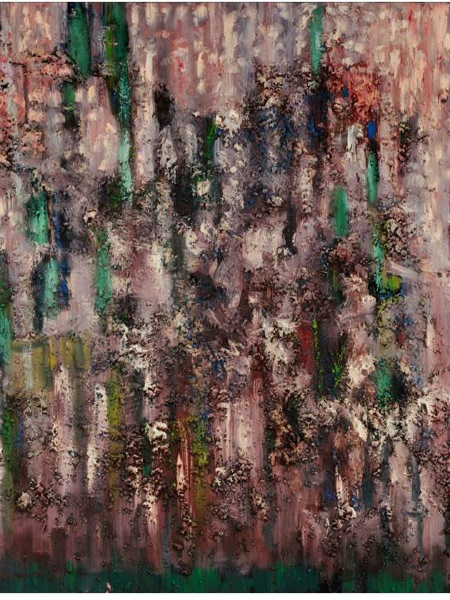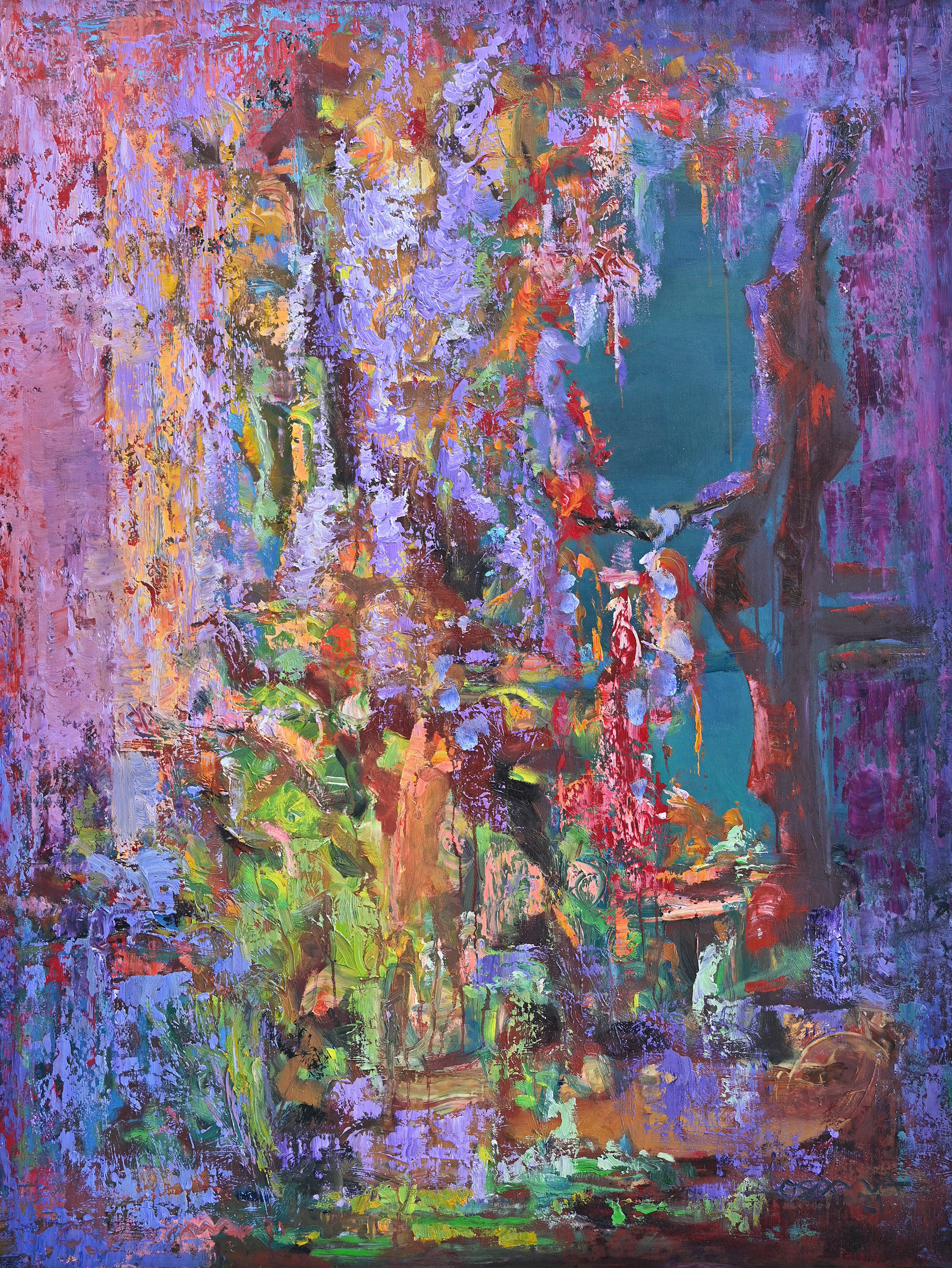Text by Maleeha Muslimani, April 11, 2022, Fine arts
Osama Said. From spring blooming to soul blooming
Exploring the realm of Osama Said's fine artworks, which span from abstract to expressionistic styles, prompts a search for the general biography and the character behind the formations and color relationships that the artist establishes on the canvas' surfaces. This biography is the key to probe his visual experience and read its oscillating aesthetics between disclosure and concealment. It also involves analyzing the connections concealed in the light and shadow variations portrayed in his works.
Calamity legacy
Osama Said was born in the village of Nahaf in Algalil, occupied territories, in 1957. His family not only experienced the tragedy of the loss of three young men due to the Zionist gangs' displacement plans, but also had to deal with the aftermath of the calamity. The artist learned about the execution of seven men in Nahaf's central square by Haganah soldiers through news reports. Motivated by the fear for his children's safety, he made the decision to smuggle his three oldest offspring out of the village, with the understanding that they would return once the situation improved. However, when the war ended, the border crossings were shut down, and the family was separated. Osama's uncles came with refugee convoys to Aleppo in Syria, and they were unable to reunite with the smuggled children. The grandfather was plagued with guilt over his decision, and the grandmother was so consumed with sorrow that she lost one of her eyes, which persisted until her passing.
“Osama's uncles arrived with the refugee convoys to the city of Aleppo in Syria, and the family has been separated ever since”
Approximately ten years after the tragic events, Said was born into a family that was overshadowed by the pain of loss. He was raised in his grandparents' home, where he inherited both the burden of their painful memories and their fondness for nature and connection to their land. Thus, the artist inherited concepts and sentiments that ranged in their connotations, between joy and tragedy, between light and shadow. It seems that the contrast between pain, love, loss, land, painful memory, and the charming nature of Algalil remained present in Said's works at all stages. Within his most vivid and visually appealing paintings, the observer can discern significant struggles that lie beneath their strokes and hues. These struggles are shaped by the interplay between light and shadow, telling the stories of both people and place.
Hurtful roses
“Osama Said interacted with the inherited memory of calamity and loss, and with the complex reality of the Palestinians in general, and the Palestinians residing in the occupied territories in particular”.
Maybe this is precisely the intention of Asad Ezzi, who summarized Osama Said's encounter by using the expression "the colors of a peacock and the claws of a cat" (1). The observer who delves into the realms of Said's artwork acts as a sampler or adventurer, only to encounter obstacles that signify a dilemma, which may relate to personal, community, worldwide, or inner and essential realities and actualities.
Being a Palestinian who was raised in occupied Palestine during 1948, Osama Said had to confront the historical recollection of calamity and deprivation, as well as the intricate situation faced by Palestinians as a whole, and those living in the occupying country specifically. Thus, we find in his works the biography of Palestine, its calamity, its cracks that split the backs of its places and its people, the confiscation of its lands, its uprisings, the torments of its children, the sanctity of its golden dome, its peasants attached to its trees, and the aesthetics of its nature, including its olive trees, almonds, mountains, rocks, and a spring that blooms to cover the earth with a dress of colors. The sensation travels towards the awareness of the artist, who then renders it in his unique artistic approach, transforming it into abstraction on the canvas, endeavoring to discover, in the emergence of nature, the emergence of the spirit.
Wounded Spring
Osama Said doesn't align with a specific artistic genre, nor does he confine himself to a singular theme, be it political or existential. Those who are acquainted with his diverse artistic journey can observe pieces that fluctuate between impressionism, expressionism, and abstraction. His study of art in Germany and periodic residency there played a significant role in influencing his creative techniques, particularly through exposure to expressionist artists.
Similarly, the person practicing meditation discovers a range of subjects in Said's writings that are not exclusively related to Palestine. For instance, a number of works portray the horrors of dictatorship and the violent and sorrowful situation faced by Arab nations during the Arab Spring. Thus, the artist narrates another aspect of spring, not far from the spring in Algalil city, which also appears in his works, despite the aesthetics of its colors, wounded and wounding: wounded by the memory of loss and uprooting, and wounding when revealing and wailing. From the Galilean Spring to the Arab Spring, Osama Said's works are trying to rise in search of a spring for the soul, as in his works that he completed in the past few years, and part of them were recently shown at Zawya Gallery in Dubai.
Consciousness memory
In recent years, the artist has broadened the scope of their creations to focus on the human and cosmic elements, contemplating questions about existence, essence, and significance, or in other words, the soul. It appears that the quest for a spiritual rebirth or the pursuit of hope amidst the bleakness of reality has been a consistent theme throughout the artist's career. The motive for art has always been the consciousness that moves him towards the subject, not the subject itself, as he says: "In many cases, the subject is no longer the main element, but rather it may become a nuisance factor... I don't actively seek out topics or go after them. I create art through drawing because it provides me with a feeling of serenity, and my connection with the objects or subjects is one that is spiritual and emotional, akin to my bond with an olive tree or an almond tree. I paint my feelings for them. Likewise, the Dome of the Rock, with which I have a strong relationship, and for me it represents the inner soul, or spirit. The dome's glow is in tune with the light in me; There are places with which we have a strong relationship that gives us a feeling or an energy, as if it pulls us within its magnetic field, and so I do not paint the place, but rather the spirit of the place drawing inspiration from the memory of the consciousness” (3)
“In Said's artworks, you can discover a variety of subjects that extend beyond Palestine. For instance, the Arab Spring is depicted in a series of works that showcase the harshness of dictatorship and the violent and sorrowful reality experienced by Arab nations.”
Said's recent art pieces are mainly free from representing a specific subject matter, and rely heavily on reducing the formal aspects and colors. This results in paintings that are seen as abstract formations of color, derived from a spiritual and emotional state. Said explains that he tries to eliminate shapes from his paintings as much as possible, unless they are absolutely necessary, because shapes can weaken the spiritual value of the artwork. By doing so, the artist can focus on his feelings and the way colors interact with each other, rather than getting preoccupied with details such as the shape, consistency, and placement of objects in the painting. However, for the viewer, the form still remains dominant, which limits their imagination from exploring the different aesthetics, layers, texture, and intensity of colors within the painting.
The soul blooming
“Osama Said's artworks provide a comprehensive visual narrative of multiple identities that extend beyond personal boundaries. Black formations that resemble frames and barriers add an element of beauty to the paintings. These works capture the essence of collective experiences, as in the event of the calamity, which mixed as a general people's tragedy with the formation of the cognitive and emotional artist”
In one of the artist's last works, shades of blue dominate most of the painting's area, and blue represents, for the artist, a masculine color, as it is stable, calm, and able to keep itself, if touched by another color, it maintains its identity as blue, unlike the feminine yellow, which is a transparent and sensitive color If a color approaches it, it quickly disappears and becomes another colour. Regarding the artwork, the red section located at the bottom symbolizes the physical and tangible world. It acts as a gateway for the viewer to access the blue space of the painting, but the viewer is met with an obstacle that divides the painting diagonally from nearly the center. This barrier represents artificial and materialistic concepts like technology, occupation, opportunism, and control that impede the journey towards enlightenment, freedom, and self-liberation.
The drama of the soul, in its attempts to escape from material distress, and overcome its barriers to the luminous expanse, is reinforced in another painting that is mainly covered with azure blue. These formations in the lower part of the work take the form of large, sharp and cutting blades, or high prison gates, which confirms the crisis of the human spirit with its confinement in the prisons of materialistic worlds and concepts. Another piece is covered in red, and it is by nature a dominant color, just like matter that controls the human in this age. The layers formed in the red space, from the overlapping of different shades of red with black, orange and yellow, in turn represent the complexities and layers of the materialistic world, while the barrier that cuts the painting longitudinally throws a weight on the visual sight of the painting, and it refers to the meanings of objection, prevention, limitation and restriction. However, a crack appears in the red of the painting at the top, and behind it is blue; The fissure refers to the window of the soul trying to find its way out from the prisons of the materialistic world.
Finally, Osama Said's artworks provide a comprehensive visual narrative of multiple identities that extend beyond personal boundaries. Black formations that resemble frames and barriers add an element of beauty to the paintings. These works capture the essence of collective experiences, as in the event of the calamity, which mixed as a general people's tragedy with the formation of the cognitive and emotional artist. As much as this experience was inspired by the aesthetics of the local, that is, the Palestinian territories, in which the artist used multiple artistic methods and different materials, such as the colors of oil, peat, and ashes, as much as it was also opened to the cosmic breadth emanating from the soul’s question about meaning. Therefore, Said's works seem to be a visually illustrated spiritual journey that narrates, through the effects of colors, their mixtures, the relationships between them, their dance, swaying, stability, glow, and subduedness, the states of the soul in its ascent.
(1) See; Asad Ezzi: The colors of a peacock and the claws of a cat, in the catalog of Smudged Sky.. Osama Said, Beit Maryam Gallery, Ramallah 2016
(2) For more on the artist's styles and the various influences on them, see; Nava Spilia, Sadeh, “Spring Blooming,” in the catalog: Osama Said.. Spring Blossom, Umm al-Fahm Art Gallery 2013, pp. 27-34
(3) Osama Said, interview with the author via Zoom, 04/04/2022 (4) same previous source.



